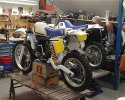Crashaholic
Husqvarna
Pro Class
I've seen reference to the Banana swingarm here and there and was wondering if anyone had information on how much these setups really helped. I think it looks pretty trick. Its definitely a great way to add shock travel without adding to the seat height. Also it seems to me that it would eliminate the tendency for a rear wheel with longer shocks to travel in a slight rearward direction upon initial compression, instead the wheel would go straight up, if rearward wheel travel is of any concern in the first place.
Let me know what you've heard, read or experienced first hand when riding with one of these modifications.
Here are a few pictures from this site as well from the general internet to get your curiosity juices flowing. Last picture isn't an actual banana shaped swingarm but I think its based on the same end result.



Let me know what you've heard, read or experienced first hand when riding with one of these modifications.
Here are a few pictures from this site as well from the general internet to get your curiosity juices flowing. Last picture isn't an actual banana shaped swingarm but I think its based on the same end result.



